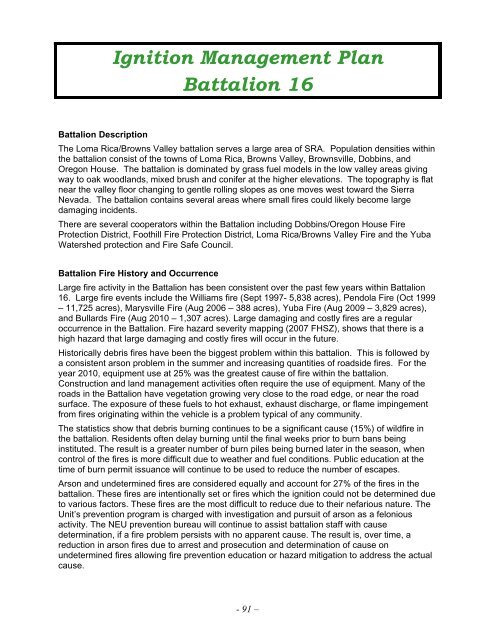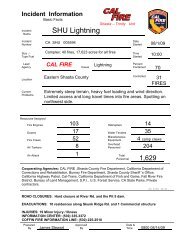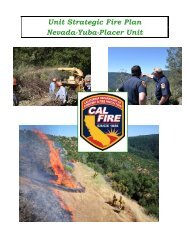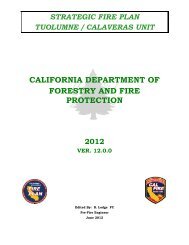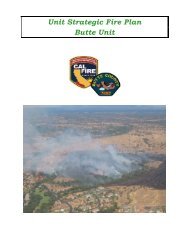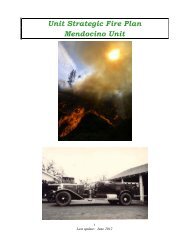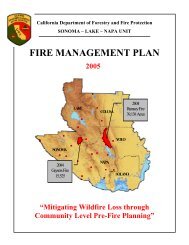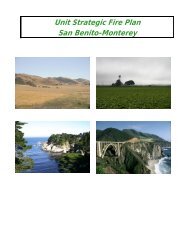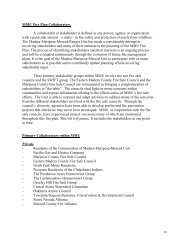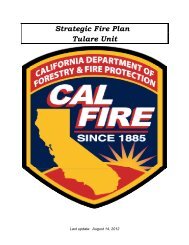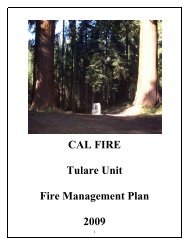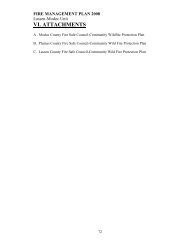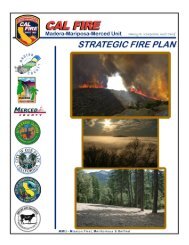Nevada-Yuba-Placer Strategic Fire Plan 2011 - Board of Forestry ...
Nevada-Yuba-Placer Strategic Fire Plan 2011 - Board of Forestry ...
Nevada-Yuba-Placer Strategic Fire Plan 2011 - Board of Forestry ...
Create successful ePaper yourself
Turn your PDF publications into a flip-book with our unique Google optimized e-Paper software.
Ignition Management <strong>Plan</strong><br />
Battalion 16<br />
Battalion Description<br />
The Loma Rica/Browns Valley battalion serves a large area <strong>of</strong> SRA. Population densities within<br />
the battalion consist <strong>of</strong> the towns <strong>of</strong> Loma Rica, Browns Valley, Brownsville, Dobbins, and<br />
Oregon House. The battalion is dominated by grass fuel models in the low valley areas giving<br />
way to oak woodlands, mixed brush and conifer at the higher elevations. The topography is flat<br />
near the valley floor changing to gentle rolling slopes as one moves west toward the Sierra<br />
<strong>Nevada</strong>. The battalion contains several areas where small fires could likely become large<br />
damaging incidents.<br />
There are several cooperators within the Battalion including Dobbins/Oregon House <strong>Fire</strong><br />
Protection District, Foothill <strong>Fire</strong> Protection District, Loma Rica/Browns Valley <strong>Fire</strong> and the <strong>Yuba</strong><br />
Watershed protection and <strong>Fire</strong> Safe Council.<br />
Battalion <strong>Fire</strong> History and Occurrence<br />
Large fire activity in the Battalion has been consistent over the past few years within Battalion<br />
16. Large fire events include the Williams fire (Sept 1997- 5,838 acres), Pendola <strong>Fire</strong> (Oct 1999<br />
– 11,725 acres), Marysville <strong>Fire</strong> (Aug 2006 – 388 acres), <strong>Yuba</strong> <strong>Fire</strong> (Aug 2009 – 3,829 acres),<br />
and Bullards <strong>Fire</strong> (Aug 2010 – 1,307 acres). Large damaging and costly fires are a regular<br />
occurrence in the Battalion. <strong>Fire</strong> hazard severity mapping (2007 FHSZ), shows that there is a<br />
high hazard that large damaging and costly fires will occur in the future.<br />
Historically debris fires have been the biggest problem within this battalion. This is followed by<br />
a consistent arson problem in the summer and increasing quantities <strong>of</strong> roadside fires. For the<br />
year 2010, equipment use at 25% was the greatest cause <strong>of</strong> fire within the battalion.<br />
Construction and land management activities <strong>of</strong>ten require the use <strong>of</strong> equipment. Many <strong>of</strong> the<br />
roads in the Battalion have vegetation growing very close to the road edge, or near the road<br />
surface. The exposure <strong>of</strong> these fuels to hot exhaust, exhaust discharge, or flame impingement<br />
from fires originating within the vehicle is a problem typical <strong>of</strong> any community.<br />
The statistics show that debris burning continues to be a significant cause (15%) <strong>of</strong> wildfire in<br />
the battalion. Residents <strong>of</strong>ten delay burning until the final weeks prior to burn bans being<br />
instituted. The result is a greater number <strong>of</strong> burn piles being burned later in the season, when<br />
control <strong>of</strong> the fires is more difficult due to weather and fuel conditions. Public education at the<br />
time <strong>of</strong> burn permit issuance will continue to be used to reduce the number <strong>of</strong> escapes.<br />
Arson and undetermined fires are considered equally and account for 27% <strong>of</strong> the fires in the<br />
battalion. These fires are intentionally set or fires which the ignition could not be determined due<br />
to various factors. These fires are the most difficult to reduce due to their nefarious nature. The<br />
Unit’s prevention program is charged with investigation and pursuit <strong>of</strong> arson as a felonious<br />
activity. The NEU prevention bureau will continue to assist battalion staff with cause<br />
determination, if a fire problem persists with no apparent cause. The result is, over time, a<br />
reduction in arson fires due to arrest and prosecution and determination <strong>of</strong> cause on<br />
undetermined fires allowing fire prevention education or hazard mitigation to address the actual<br />
cause.<br />
- 91 –


